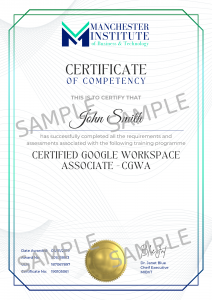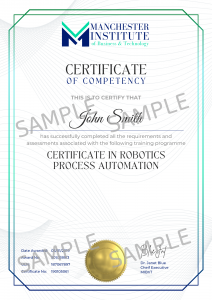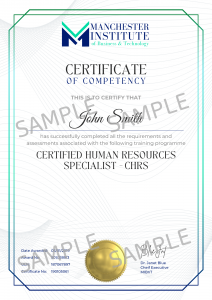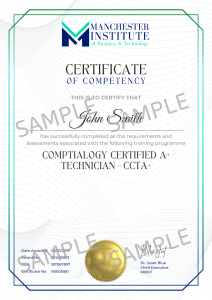All Courses

$200.00 $99.00
Duration: 5 days
Transform how you create, collaborate and share with Google Drive, the popular cloud-based storage service available to anyone from their Gmail account. In this course, you will learn the fundamentals of Drive and its built-in essential productivity apps to work smarter from virtually anywhere, online or offline.
You will learn how to whip up presentations in Slides, edit Docs with your team in real-time, and create pivot tables and charts in Sheets. You’ll also learn how to design infographics in Drawings and make surveys in Forms. By the end of the training, you will have mastered the fundamentals of Google Drive and Apps to increase your productivity and seamlessly collaborate with others.
Designed for beginners, you don’t need any prior knowledge to get started with this Google Drive course.
After this course, you will be able to:
- Upload, download, delete and restore files in Google Drive.
- Install and use the offline Drive client to sync files to your computer.
- Share files with collaborators and set permissions for viewing, editing and commenting.
- Discover how to use Google Drive on iOS devices.
- Create Google Docs, Slides, Sheets, Forms and Drawings.
- Insert images, links, comments, footnotes and track changes in Docs.
- Use themes, format slides and add animations and transitions in Slides.
- Sort and filter data, create Pivot Tables and charts, and apply formatting to Sheets.
- Create different question types, a self-correcting quiz and an overview of responses in Forms.
- Insert and manipulate shapes and create an infographic in Drawings.
- Add and remove third-party add-ons in native Google apps.
Who is this Google Drive course for:
- Anyone new to Google’s productivity apps or transitioning from the Microsoft Office suite
- Anyone looking to start with the basics of how to use Google Drive to learn some time-saving tips
- Ideal Google Drive training for teachers, students, teams, freelancers, and business professionals
Course Outline
Using Google Drive
- Managing files
- Creating and managing folders
- Locating files
- Changing display and settings
- Sharing files and folders
Using Gmail
- Personalizing settings
- Managing your inbox
- Managing and communicating with contacts
- Locating messages
- Using Gmail Offline
Working In Docs
- Setting up pages
- Inserting non-text elements
- Changing text attributes
- Formatting text blocks
- Using content management tools
- Inserting and editing tables
- Collaborating and sharing in Docs
- Download as tools
Working In Sheets
- Managing values, rows, cells, or columns
- Formatting sheets and cells
- Inserting non-text elements
- Using functions
- Managing and transforming data
- Collaborating and sharing in Sheets
- Importing and converting from other file types
Working In Slides
- Building a presentation
- Working with text
- Working with non-text elements
- Arranging objects
Sample Certificate


$1,800.00 $899.00
Duration: 10 days
The demand for RPA and intelligent automation has never been greater, with many jobs available to qualified RPA professionals. Enterprises are looking for trained RPA professionals to boost digital workforce ROI. MIBnT offers globally recognized certifications that demonstrate your RPA knowledge and skills proficiency.
Our industry-leading RPA certification is ideal for developers, IT professionals, business analysts, project managers, and others involved with creating or maintaining your organization’s RPA platform. The certifications address core competencies like automating business processes, monitoring all processes of the RPA infrastructure, and managing a Digital Workforce of any size.
LEARNING OUTCOME:
- Applying robotics process automation to certain repetitive tasks.
- A drastic reduction of costs in the company; efficiency in the application of resources, and dispense labour for automated tasks.
- By automating processes using machines, we can achieve much higher productivity peaks, depending only on our available resources.
- Robots can interact with several different sources and databases, allowing them to collect this data and present it in an orderly manner to end-users: humans.
- Reduce operational risk which helps to optimize resources and increase efficiency at the operational level. In other words, it is possible to do more with less, eliminate production bottlenecks, and reduce human errors.
- Abandon tasks with little added value for the organization. That way, we can focus more on our customers and provide a more focused approach to their needs.
Course Outline
Module 1: AI/ML with RPA
- Where does AI/ML fit in RPA?
- Looking ahead
Module 2: Introduction to RPA
- What is RPA
- Definition
- Pros and Cons
- RPA Tools / Vendors
- Activity to Understand and Introduce RPA
- RPA vs Traditional Automation
- Process driven
- Data Driven
Module 3: RPA Applications
- Processes suitable for RPA
- Criteria/Guidelines
- Limitations/Challenges
- Activities/Exercises
- Benefits of RPA
- Opportunity
- Areas for RPA
- RPA Hands-On Activities and Demo
- Creating first RPA Bot
- Automate Invoice, Processing, or Reports
- Extract, Merge or Reconcile Information via RPA
- Evaluating RPA
- Workflows
- Processes
- Different Types of RPA
- Skills
- Checklist
- RPA Use Cases
- Discussion & Examples
- Application Scenarios
- Cost
- Implementing
- RPA in Accounting/Finance
Module 4: RPA in the Future
- Future Advancements and Applications of RPA
- Final Portfolio
- Portfolio submission and final project
Sample Certificate


$3,000.00 $1,249.00
Duration: 20 days
This course will equip you with the skills needed to become an expert in this rapidly growing domain. You will learn comprehensive approaches to protecting your infrastructure, including securing data and information, running risk analysis and mitigation, architecting cloud-based security, achieving compliance and much more with this best-in-class program.
Module 1: Cyber-crime and Forensics Awareness
- Upon successful completion of this module, you will have a systematic understanding of knowledge, and critical awareness of current cyber security challenges and how they are exploited through cybercrime. This includes gaining practical knowledge of how to perform and critical evaluate a crime scene from a digital perspective.
- This module also enables a conceptual understanding that enables the learner to critically evaluate and engage in scholarship in the discipline, including proposing and testing both research and investigative hypotheses.
- The module covers many different aspects of cybercrime and how they are fundamentally possible, often through exploiting weaknesses in computer and network security.
- The module presents an introduction to forensic analysis of digital systems, which focuses on recovering deleted data from persistent data storage mechanisms (e.g. hard drives).
Module 2: Emerging Technologies for Cyber Physical Systems
- Cyber-Physical Systems (CPS) are collections of physical and software components that communicate and interact with users via networks.
- CPS extend the traditional capabilities of embedded systems by incorporating sensor networks and data services to enable previously disparate systems to become more integrated through ‘smart’ capabilities. Examples of CPS include the Internet of Things (IoT), smart cities and digital manufacturing.
- This module will enable learners to explore contemporary issues in relation to emerging technologies that can be used to realise cyber-physical systems.
Module 3: Digital Forensics
- Digital Forensics (DF) is the process of identifying, acquiring, analysing and reporting on digital evidence (DE) used in a wide range of investigations.
- Digital Forensic Investigations (DFIs) have a variety of applications, being used in civil, administrative, and criminal proceedings in pursuit of DE.
- A typical DFI would involve the investigation of crimes such as hacking and possession of illegal imagery, etc. The aim of this module is to provide the learner with the knowledge and critical understanding of the key concepts in Digital Forensics.
- Through this module, the learner will be taught how to identify, preserve, extract and analyse digital evidence in a forensically-sound manner and report on the findings. Furthermore, this module will equip the learner with practical skills in applying specialised forensic tools, such as FTK Imager and Autopsy, and techniques, such as data carving and file system analysis, to a specific application scenario.
Module 4: Applications of Artificial Intelligence in Cyber Security
- Artificial intelligence (AI) is the study and development of intelligent behaviour exhibited in computational form. Its purpose is to demonstrate intelligent characteristics that provide enriched system functionality beyond that of traditional software systems.
- The benefits of AI spread across many application areas, and one such area is that of cyber security.
- Artificial intelligence can be loosely categorised into symbolic and statistical approaches, which are often used depending on application requirements.
- In this module, the learner will study the different types of AI systems and focus on their different application use cases in cyber security.
Module 5: Security Architecture
- Security architecture is a unified security design that addresses the necessities and potential risks involved in a certain scenario or environment.
- It also specifies when and where to apply security controls.
- The design process is generally reproducible.
In security architecture, the design principles are reported clearly, and in-depth security control specifications are generally documented in independent documents. - System architecture can be considered a design that includes a structure and addresses the connection between the components of that structure.
Module 6: Incident Response
- Incident response (IR) is the steps used to prepare for, detect, contain, and recover from a data breach. An incident response plan is a document that outlines an organization’s procedures, steps, and responsibilities of its incident response program.
- Incident response planning often includes the following details:
- how incident response supports the organization’s broader mission
- the organization’s approach to incident response
- activities required in each phase of incident response
- roles and responsibilities for completing IR activities
- communication pathways between the incident response team and the rest of the organization
- metrics to capture the effectiveness of its IR capabilities
Module 7: Final Projects
- Students should submit a portfolio of their findings and understanding of attack types and incident report.
- They will also provide evidence of understanding on how to prevent and detect a cybercrime and a digital forensic.
Sample Certificate


$1,600.00 $799.00
Duration: 10 days
This course is intended to introduce participants to Artificial Intelligence, Machine Learning. Multiple hands-on activities will highlight different machine-learning applications, such as computer vision and neural networks. We will discuss how professionals will be affected through the many varied applications of these new technologies, and how they are already impacting workplaces today.
LEARNING OUTCOME:
- Eliminating the tasks given to humans that are routine and time-consuming without encouraging creative thinking or decision-making. It is an opportunity to show humans what is human, enhancing their capacities in creative and decision-making areas.
- Learners will gain a thorough understanding of the concept of Artificial Intelligence and its applications.
- Relating machine learning to its umbrella term of artificial intelligence.
- By machines, we can achieve much higher productivity peaks, depending only on our available resources.
Course Outline
Module 1: Introduction to Artificial Intelligence (AI) and Machine Learning (ML)
- Automation vs AI vs ML
- Hands on: Are You Smarter Than Paper?
- Hands on: Quickdraw
- Image Processing, Natural Language Processing, Reinforcement Learning
- AI History
- Recent Examples
Module 2: How Machines Learn
- Supervised Learning
- Classification Examples
- Hands on: Neural Networks
- Prediction Models
- Image Classification
- Unsupervised Learning
Module 3: AI applications
- Domains: Agriculture, Cultural Preservation, etc.
- Apps: Seeing AI, Sketch2Code, etc.
Module 4: Hands on with Google AI
- Basics of Google AI:
- Creating an Experiment
- Training and Evaluating Models
- Training Experiments vs Predictive Experiments
- Deploying Predictive Experiments
- Predictive analytics applications:
- Activity: Speech recognition
- Activity: Image scanning
- Activity: Movement detection
- Basics of Google AI:
Final Project & Assessment
Sample Certificate


$1,200.00 $599.00
Duration: 10 days
Master the basics of digital marketing with our course which consists of 26 modules to master the skills of digital marketing, all created by Google trainers, packed full of practical exercises and real-world examples to help you turn knowledge into action.
Why get certified?
- Improve your CV: Getting certified shows employers that you have a clear understanding of the core concepts of digital marketing. You can also add the qualification to your CV, and easily upload it to your LinkedIn profile.
- Find a job: Becoming certified shows you have strong digital skills and that you’re motivated to learn: two essential qualities in the workplace. Demonstrating these qualities can help improve your chances of finding the job you want.
- Develop your career: Improving your digital knowledge can help you find a job, get promoted, or start a whole new career.
Course Outline
- The Online Opportunity: Today’s World Is A Digital One, With Nearly Half Of The Global Population Online. With So Many People Using The Internet, It Makes Sense For A Business To Tap Into Digital. Find Out What Opportunities Exist And How A Website, Videos Or Social Media Could Help You Reach Your Goals.
- Your First Steps In Online Success: There Are Many Ways To Promote A Business Online. But Before You Can Get Started, You Should Familiarize Yourself With How These Digital Channels Work, Which Options Are Best Suited To You, And How To Set Up A Clear Plan Or Strategy That Will Help You Achieve Your Goals And Assess Your Results.
- Build Your Web Presence: From Websites To Local Listings, Mobile Apps To Social Media, There Are Lots Of Ways To Be Found Online. If A Website Is The Best Fit For Your Goals, You’ll Need To Have A Basic Grasp Of How They Work. Even More Importantly, Having Design And Usability Best Practices Under Your Belt Will Help You Build A Website That Tells Your Story Well, And Allow Your Customers To Find What They Need.
- Plan Your Online Business Strategy: From Identifying Your Goals To Knowing How To Track Your Progress, This Topic Will Show You How To Put Your Best Foot Forward When Creating A Digital Business Strategy. Learn How To Stand Apart From The Competition And How To Impress Customers At Every Point Of Their Experience.
- Get Started With Search: Search Engines Make It Simple To Find What You’re Looking For With A Click Of A Button. But How Do They Work, And How Can You Improve Your Visibility On Them? Learn The Difference Between Organic And Paid Search Results And Why Advertising On Search Engines Is So Effective.
- Get Discovered With Search: Search Engine Optimization Might Sound Like A Mouthful, But Once You Understand How Search Engines Work You’ll Be On Your Way To Becoming SEO Confident. Learn How To Develop An Adaptable SEO Plan, Identify The Most Effective Keywords, And Which Tools Can Help You Measure What Matters.
- Make Search Work For You: Optimising Web Pages Correctly Means More People Can Find Your Content Faster. There Are Lots Of Ways To Achieve This, So Choosing The Most Effective Methods Will Save You Time And Resources. In This Topic You’ll Learn How To Master Meta Tags, Backlinks, International SEO And More.
- Be Noticed With Search Ads: Search Engine Marketing (SEM) Can Open Up A World Of Opportunities When It Comes To Promoting Your Service Or Product. By Specifically Targeting People Interested In Your Website, You Can Use Online Advertising To Directly Connect With Future Customers. Learn How An SEM Auction Works And Which Elements Are Important To Master So You Can Create Ads That Stand Out From The Crowd.
- Improve Your Search Campaigns: The World Of Search Engine Marketing (SEM) Is Full Of Opportunities, But To Benefit You’ll First Need To Master Research Tools And Keyword Selection. From There, You Can Improve And Optimize Your Search Campaigns To Ensure You Get Maximum Value For What You Spend.
- Get Noticed Locally: If You Have A Physical Storefront, You’ll Need To Harness Local Online Marketing In Order To Reach Customers. Ensure You’re Visible To People Close To Your Store By Creating A Listing In Local Directories, Engaging In Mobile Marketing And Building A Local Search Presence.
- Help People Nearby Find You Online: Thanks To Search Engines, Local Directories And Social Networks, Reaching Customers Who Are Physically Close To A Store Is A Relatively Easy Task. Learn Some Ways To Take Advantage Of That Unique Opportunity To Attract New Customers, By Mastering Local Advertising, Mobile Marketing And More.
- Get Noticed With Social Media: Everyone’s On Social Media, So It Makes Sense For Your Business To Be There Too. Take Advantage Of Popular Social Media Networks By Understanding Why You Need To Be There, Joining The Right Social Media Sites And Growing Your Presence By Engaging With Your Networks.
- Deep Dive Into Social Media: An Organized Social Media Plan And Strategy Will Go A Long Way In Saving You Time And Energy. Become Familiar With What Social Content Works Best, Why Advertising On Social Can Be A Powerful Addition To Your Strategy, And How To Measure Success So That You Can Optimize Future Social Content.
- Discover The Possibilities Of Mobile: Web Browsing On-The-Go Is Very Much A Part Of Everyday Life – Which Is Why A Mobile Presence Is Important For Businesses To Embrace. Learn About Mobile SEO. The Differences Between Mobile Sites And Mobile Apps, And Which Type Of Mobile Marketing Is Right For Your Goals.
- Make Mobile Work For You: With Mobile Video Consumption On The Rise, It Makes Sense To Include Mobile In Your Advertising Strategy. Understanding The Options And Tools Available And How To Choose The Right Keywords And Ad Formats Will Set You Up To Succeed In Your First Mobile Marketing Campaign.
- Get Started With Content Marketing: Content Marketing Is A Great Way To Build Trust And Increase Site Traffic. In This Topic, You’ll Learn How To Write For Online Audiences, Organise Production And Promotion, Choose The Right Format Based On Your Content, And Track Your Content Marketing Success.
- Connect Through Email: Email Marketing Is A Great Way To Connect And Stay In Touch With Your Customers. From Building A Contact List To Learning How To Design Emails That Really Stand Out, This Topic Will Teach You The Basics Of Effective Email Marketing Campaigns.
- Advertise On Other Websites: By Incorporating A Mix Of Both Display And Search Engine Advertising, You’ll Be Able To Maximize Your Online Visibility. Learn About The Benefits Of Display And Search Ads, How They Differ And How To Find And Target The Right Audience, So That You Have The Skills To Correctly Structure Your Ad Campaigns.
- Deep Dive Into Display Advertising: To Make Display Ads Succeed, It Is Important To First Understand How Advertising Networks Connect Businesses Who Want To Advertise, With Websites With Ad Space To Sell. You Can Then Harness The Power Of Retargeting Solutions To Stay Top Of Mind And Really Move Potential Customers Through The Sales Funnel.
- Make The Most Of Video: Today, Video Is A Vibrant And Popular Part Of The Online Experience. Connecting With Customers Through This Versatile Medium Can Open Up Valuable Advertising And Content Marketing Opportunities. Learn How To Integrate Video Into Your Online Strategy, Plan And Produce Videos On A Budget, And Promote Them So That They’re Seen By The Right People.
- Get Started With Analytics: Web Analytics Can Provide A World Of Information When It Comes To Understanding Your Web Users. By Clearly Outlining Your Business Goals, You Can Then Utilize Analytics Data To Help You Refine And Improve Your Website And Meet Your Objectives.
- Find Success With Analytics: Analytics Tools Provide Loads Of Data, But They Don’t Always Give Easy Answers. Dive A Little Deeper Into Web Analytics, And You’ll Soon Be Able To Measure Organic Search Analytics, Understand SEM Data And Master Segmentation Techniques.
- Turn Data Into Insights: Knowing How To Turn Digital Data Into Actionable Insights Can Improve Your Online Campaign Results And Help You Meet Your Goals. In This Topic, You’ll Learn About The Data Cycle, How To Draw Actionable Insights From Raw Data, And Which Tools Can Help You Manage Digital Data Efficiently. We’ll Also Cover How To Present Information In A Way That Will Make The Most Impact With A Target Audience.
- Build Your Online Shop: Tap Into The World Of E-Commerce And Learn How To Effectively Sell Your Products Online. From The Tools You’ll Need To Build Your Online Shop From Scratch, To Payment Methods And Managing Orders, This Introductory Topic Will Get You On Your Way.
- Sell More Online: Once Your Online Shop Is Set Up, It’s Time To Ensure Everything Is Optimised Correctly So That Customers Have The Smoothest User Experience Possible. Each Touchpoint Is An Important Communication Opportunity Between You And Your Customers: From Signing In And Browsing To Checking Out And Receiving Promotions About Sales.
- Expand Internationally: Ready To Dive Into The Global Market? Before Launching Products Or Services To An International Audience, It’s Important To Validate Your New Markets, Know The Difference Between Translation And Localisation And Ensure You Have The Technical Infrastructure To Manage It All. Once You Have A Solid Set-Up, Consider Advertising Across Borders So That Your Marketing Messages Are Seen By The Right People, Wherever They Are.
Sample Certificate


$3,000.00 $1,499.00
Duration: 5 days
If you are an HR professional who wants to advance or excel in your career, earning a Certified Human Resources Specialist (CHRS) certification will take you to the next level in strategic human resources management. This training program is the premier certification for HR professionals and managers who want to add greater value through a thorough understanding of human resources management.
The challenge before you is to drive organizational success through effective, strategic human resource management (HRM) practices and policies, and to comply with myriad employment and labor laws at both the state and federal levels. In this workshop, you will acquire an extensive set of reference materials and resources while building your professional HR network.
After this course you will be able to:
- Drive organizational success through strategic HRM practices
- Comply with employment and labour laws, minimizing risk
- Create a safe and healthy work environment
- Follow ethical standards of conduct
- Recruit and select the right people for the right positions
- Implement performance management, appraisal methods, and disciplinary methods that increase employee effectiveness
- Utilize compensation and benefits, including wellness programs, to achieve and maintain a competitive edge
- Build or expand your professional HR network
Course Outline
Introduction To HRM
- Introduction to Human Resources Management
- Key Competencies for HR Professionals
- Strategic Human Resources Management
- Communications and Demonstrating Value
Human Resources In The Global Context
- Employment Law
- Ethics
- Recordkeeping and Reporting
Talent Acquisition, Diversity & Inclusion
- Job Analysis and Design
- Workforce Planning Analytics
- Recruitment, Sourcing and Selection
Employee Retention
- Compensation and Benefits
- Health, Safety and Security
- Employee Discipline and Separation
Organizational Excellence
- Training and Development
- Performance Management
Sample Certificate


$3,000.00 $1,499.00
Duration: 5 days
CMP is administered by MIBnT; one of the most renowned institutes for business management and communications in the UK. By earning CMP candidates demonstrate that they have mastered the management and business English body of knowledge, obtained the skills of a professional management executive, and are committed to MIBnT's core values and code of ethics.
Course Outline
Management Functions & Styles
Leadership & Motivation
Introduction to Human Resources Management
Understanding Financial Information
Conflict Management
Innovation in Time Management
Team Building
Setting up Effective KPIs
Sample Certificate

$1,000.00 $499.00
Duration: 10 days
If you are getting ready for a career as an entry-level information technology (IT) professional or computer service technician, the CCT-A+ course is the first step in your preparation. The course will build on your existing user-level knowledge and experience with personal computer (PC) software and hardware to present fundamental skills and concepts that you will use on the job. In this course, you will acquire the essential skills and information you will need to install, configure, optimize, troubleshoot, repair, upgrade, and perform preventive maintenance on PCs, digital devices, and operating systems.
This course can benefit you in two ways. Whether you work or plan to work in a mobile or corporate environment where you have a high level of face-to-face customer interaction, where client communication and client training are important, or in an environment with limited customer interaction and an emphasis on hardware activities, this course provides the background knowledge and skills you will require to be a successful computer technician.
This course is designed for individuals who have basic computer user skills and who are interested in obtaining a job as an entry-level IT technician. This course is also designed for students who are seeking the CCT-A+ certification.
After completing this course, students will be able to:
* Identify the hardware components of personal computers and mobile digital devices.
* Identify the basic components and functions of operating systems.
* Identify networking and security fundamentals.
* Identify the operational procedures that should be followed by professional PC technicians.
* Install, configure, and troubleshoot display devices.
* Install and configure peripheral components.
* Manage system components.
* Manage data storage.
* Optimize and maintain Microsoft Windows.
* Work with other operating systems.
* Identify the hardware and software requirements for client environment configurations.
Course Outline
Information Technology Fundamentals
- Hardware Fundamentals
- Operating System Fundamentals
- Networking and Security Fundamentals
- Safety and Operational Procedures
- Safety and Operational Procedures
- Supporting Display Devices
Operating Systems Overview
- Installing and Configuring Peripheral Components
- Managing System Components
- Managing Data Storage
Installing Operating System
- Installing and Configuring Microsoft Windows
- Optimizing and Maintaining Microsoft Windows
- Working With Other Operating Systems
Customized Client Environments
- Configuring Operating System
- Supporting Printers and Multifunction Devices
- Security Threats, Vulnerabilities and Controls
- Implementing Security Controls
- Troubleshooting System-Wide Issues
Sample Certificate


$1,000.00 $499.00
Duration: 10 days
Comptialogy Network+ is the premier vendor-neutral networking certification. Our CCTN+ course is designed to provide in-depth understanding and the foundation you need not only to be productive on the job but also to be successful in more specialized topics and in your pursuit of vendor-specific certifications.
Earning CCTN+ certification increases your value in the marketplace, providing proof of your knowledge, skills, and ability to manage, maintain, troubleshoot, install, operate, and configure basic network infrastructure. Our CCTN+ course points you in the right direction, allowing you to demonstrate the concepts covered on the exam in a real-world, hands-on environment.
This course is designed for individuals who have basic networking skills and who are interested in obtaining a job as an entry-level networking technician. This course is also designed for students who are seeking the CCTN+ certification.
After completing this course, students will be able to:
* Identify network technologies.
* Install and configure networking capabilities.
* Support mobile digital devices.
* Support printers and multifunction devices.
* Identify security threats, vulnerabilities, and controls.
* Implement security controls.
* Troubleshoot system-wide issues.
* Identify basic network theory concepts and major network communications methods.
* Describe bounded network media.
* Identify unbounded network media.
* Identify the major types of network implementations.
* Identify TCP/IP addressing and data delivery methods.
* Implement routing technologies.
* Identify the major services deployed on TCP/IP networks.
* Identify the infrastructure of a WAN implementation.
* Identify the components used in cloud computing and virtualization.
* Describe basic concepts related to network security.
* Prevent security breaches.
* Respond to security incidents.
* Identify the components of a remote network implementation.
* Identify the tools, methods, and techniques used in managing a network.
* Describe troubleshooting of issues on a network
Course Outline
Network Fundamentals
- Network Theory
- Bounded Network Media
- Unbounded Network Media
- Network Implementations
TCP/IP Addressing & Services
- TCP/IP Addressing and Data Delivery
- Routing
- TCP/IP Services
Networking Technologies
- WAN Infrastructure
- Cloud and Virtualization Technologies
Network Security
- Network Security Basics
- Preventing Security Breaches
- Responding to Security Incidents
Network Access & Troubleshooting
- Remote Networking
- Network Management
- Troubleshooting Network Issues
Sample Certificate
